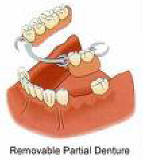

There are two basic methods of replacing missing teeth, fixed and removable. Fixed includes dental bridges and implants. Removable includes partial and complete dentures. It is preferable to employ fixed prosthesis whenever possible.
Partial Dentures
A bridge—a device used to replace missing teeth—attaches artificial teeth to adjacent natural teeth, called abutment teeth. Bridges can be applied either permanently (fixed bridges), or they can be removable. Fixed bridges are applied by either placing crowns on the abutment teeth—to provide support for artificial teeth—or by bonding the artificial teeth directly to the abutment teeth. Removable bridges are attached to the teeth by either metal clasps or by precision attachments.

Removable partial dentures usually consist of replacement teeth attached to pink or gum-colored plastic bases, which are connected by metal framework. Removable partial dentures attach to your natural teeth with metal clasps or devices called precision attachments. Precision attachments are generally more esthetic than metal clasps and they are nearly invisible. Crowns on your natural teeth may improve the fit of a removable partial denture and they are usually required with attachments. Dentures with precision attachments generally cost more than those with metal clasps. Consult with your dentist to find out which type is right for you.
Over time, adjusting the denture may be necessary. As you age, your mouth naturally changes, which can affect the fit of the denture. Your bone and gum ridges can recede or shrink, resulting in a loose-fitting denture. Dentures that do not fit properly should be adjusted by your dentist. Loose dentures can cause various problems, including sores or infections. See your dentist promptly if your denture becomes loose. You can do serious harm to your denture and to your health by trying to adjust or repair your denture. A denture that is not made to fit precisely by a dentist can cause irritation and sores. Using a do-it-yourself kit can damage the appliance beyond repair. Glues sold over-the-counter often contain harmful chemicals and should not be used on a denture.
If your denture no longer fits properly, if it breaks, cracks or chips, or if one of the teeth becomes loose, see your dentist immediately. In many cases, dentists can make necessary adjustments or repairs, often on the same day. Complicated repairs may require that the denture be sent to a special dental laboratory.
Complete Dentures

If you’ve lost all of your natural teeth, whether from periodontal disease, tooth decay or injury, complete dentures can replace your missing teeth and your smile. Replacing missing teeth will benefit your appearance and your health. Without support from the denture, facial muscles sag, making a person look older. You’ll be able to eat and speak—things that people often take for granted until their natural teeth are lost.
There are various types of complete dentures. A conventional full denture is made and placed in the patient’s mouth after the remaining teeth are removed and tissues have healed which may take several months. An immediate complete denture is inserted as soon as the remaining teeth are removed. The dentist takes measurements and makes models of the patient’s jaws during a preliminary visit. With immediate dentures, the denture wearer does not have to be without teeth during the healing period.
Even if you wear full dentures, you still must take good care of your mouth. Brush your gums, tongue and palate every morning with a soft-bristled brush before you insert your dentures to stimulate circulation in your tissues and help remove plaque.
Complete dentures are called "conventional" or "immediate" according to when they are made and when they are inserted into the mouth.
At our office we prefer to take advantage of both. An immediate “provisional” denture is inserted at the time of extractions. Then in 6 to 8 weeks, after the healing has occurred, a conventional denture is made. This allows the patient to have a denture during the healing period and the construction of the final denture.
Over time, dentures will need to be relined, rebased, or remade due to normal wear. To reline or rebase a denture, the dentist uses the existing denture teeth and refits the denture base or makes a new denture base. Dentures may need to be replaced if they become loose and the teeth show signs of significant wear. Dentures become loose because a mouth naturally changes with age. Bone and gum ridges can recede or shrink, causing jaws to align differently. Shrinking ridges can cause dentures to fit less securely. Loose dentures can cause health problems, including sores and infections. A loose denture also makes chewing more difficult and may change your facial features. It's important to replace worn or poorly-fitting dentures before they cause problems.
Even with full dentures, you still need to take good care of your mouth. Every morning, brush your gums, tongue and palate with a soft-bristled brush before you put in your dentures. This removes plaque and stimulates circulation in the mouth. Selecting a balanced diet for proper nutrition is also important for maintaining a healthy mouth.
Your dentist will advise you about how often to visit. Regular dental check-ups are important. The dentist will examine your mouth to see if your dentures continue to fit properly. The dentist also examines your mouth for signs of oral diseases including cancer..
With regular professional care, a positive attitude and persistence, you can become one of the millions of people who wear their dentures with a smile.

